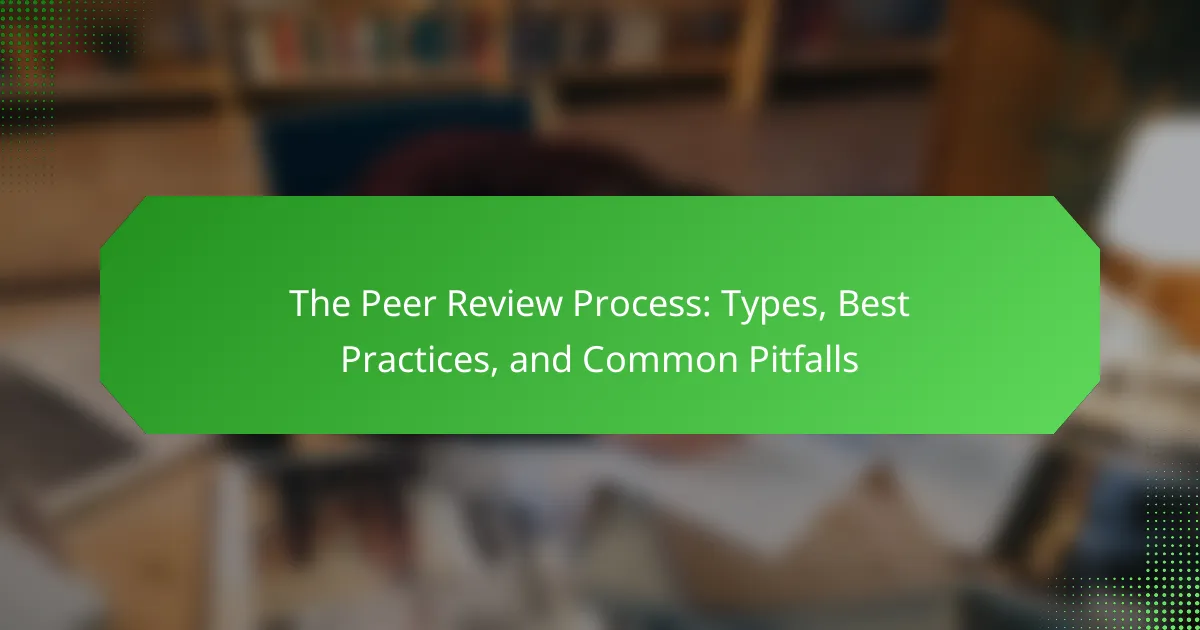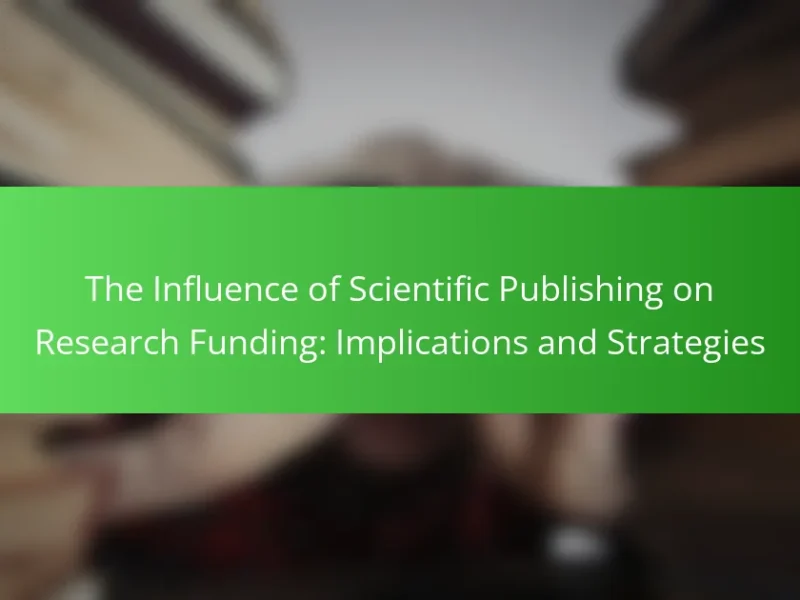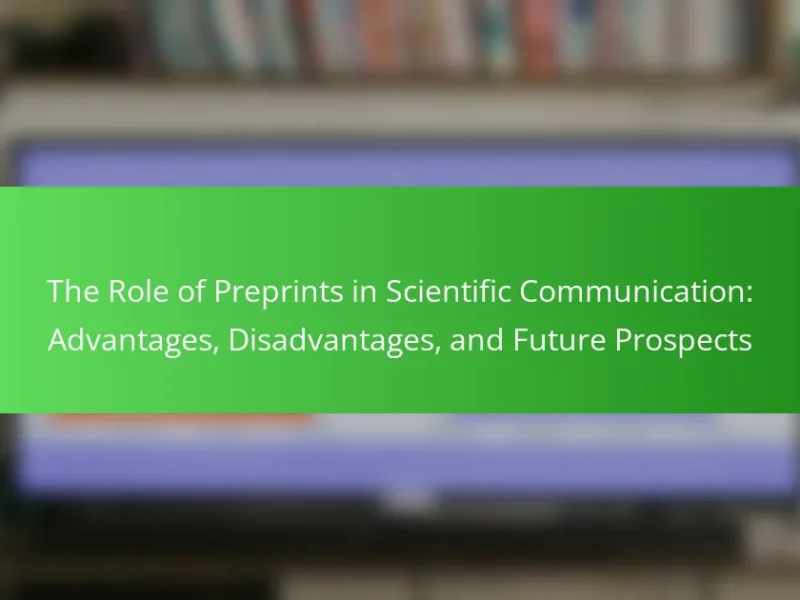The peer review process is a critical evaluation method used to assess academic work prior to publication, involving experts who review manuscripts for quality, validity, and originality. This article outlines the various types of peer review, including single-blind, double-blind, open, and post-publication review, each with distinct characteristics and implications for bias and transparency. It also highlights best practices for conducting peer reviews, such as maintaining objectivity and providing constructive feedback, while addressing common pitfalls like bias and inadequate reviewer expertise that can undermine the process. Understanding these elements is essential for enhancing the credibility and integrity of scholarly publishing.
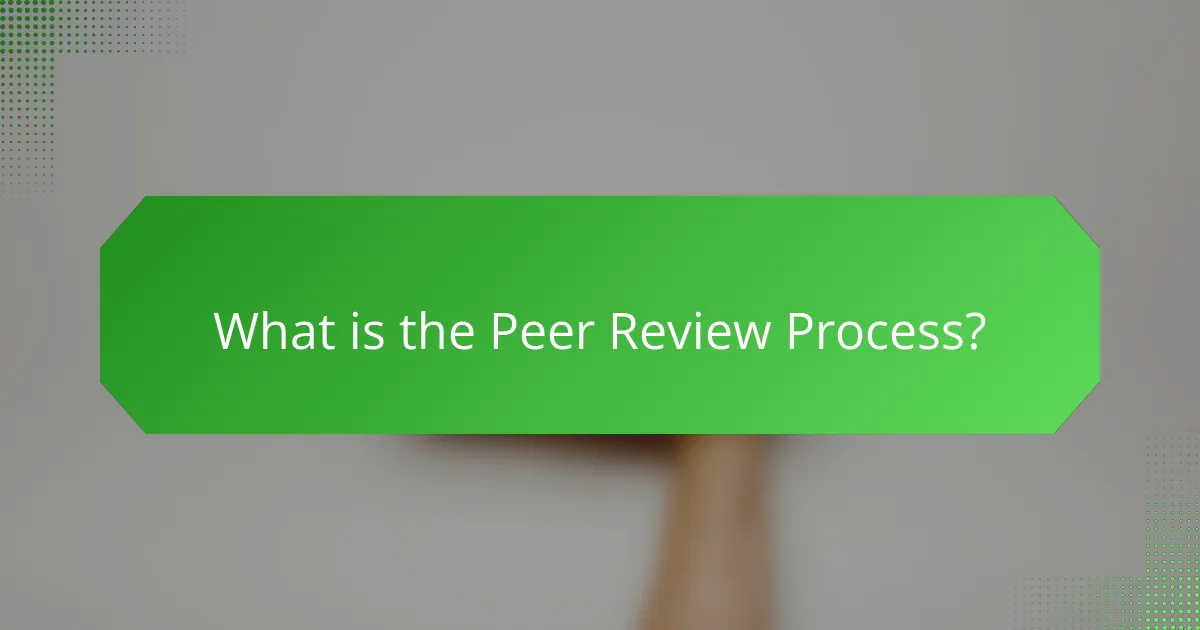
What is the Peer Review Process?
The peer review process is a method used to evaluate academic work. It involves experts in the field reviewing a manuscript before publication. These reviewers assess the quality, validity, and originality of the research. The process helps ensure that only high-quality research is published. Reviewers provide feedback to authors, suggesting improvements or identifying flaws. This iterative process can lead to revisions and resubmissions. The peer review process is critical for maintaining academic standards. It enhances the credibility of published research.
Why is the Peer Review Process important in research?
The peer review process is important in research because it ensures the quality and credibility of scholarly work. This process involves experts evaluating research before publication. It helps identify errors, biases, and methodological flaws. Peer reviewers provide constructive feedback to authors. This feedback can improve the clarity and rigor of the research. Furthermore, the peer review process enhances the reliability of published findings. A study published in the journal “Nature” found that peer-reviewed articles are more likely to be cited than non-reviewed ones. This highlights the significance of peer review in establishing trust in scientific literature.
What role does peer review play in maintaining research quality?
Peer review plays a critical role in maintaining research quality. It involves evaluation by experts in the field before publication. This process ensures that research meets established standards. Reviewers assess the validity, significance, and originality of the work. They provide constructive feedback to improve the study. Peer review helps identify errors and biases in research. Studies show that peer-reviewed articles are more reliable. According to a 2018 study in the journal “Nature,” peer-reviewed research is cited more frequently than non-reviewed work. This underscores the importance of peer review in enhancing the credibility of scientific literature.
How does peer review impact the credibility of published work?
Peer review significantly enhances the credibility of published work. It involves the evaluation of research by experts in the same field before publication. This process helps ensure that the research methodology is sound and that the findings are valid. Peer reviewers assess the originality and relevance of the work. They also check for adherence to ethical standards. Studies show that peer-reviewed articles are more likely to be cited and trusted by the academic community. According to a study published in the journal “Nature,” peer-reviewed research is viewed as more reliable than non-peer-reviewed sources. This process ultimately fosters trust in scientific literature and contributes to the advancement of knowledge.
What are the main goals of the Peer Review Process?
The main goals of the Peer Review Process are to ensure the quality and credibility of scholarly work. This process involves evaluating research for accuracy, validity, and originality. Reviewers assess methodologies and findings to identify potential flaws. They provide constructive feedback to authors for improvement. Additionally, peer review helps maintain ethical standards in research. It serves as a gatekeeping mechanism for publication in academic journals. Studies show that peer-reviewed articles are more likely to be trusted by the scientific community. The overall aim is to enhance the reliability of published research.
How does peer review contribute to the advancement of knowledge?
Peer review contributes to the advancement of knowledge by ensuring the quality and credibility of research. It involves the evaluation of scholarly work by experts in the same field. This process helps identify errors, biases, and gaps in research. As a result, only robust and validated findings are published. Peer review also fosters critical dialogue among researchers. It encourages the sharing of ideas and methodologies. This collaborative environment enhances the overall body of knowledge. Studies show that peer-reviewed articles are more likely to be cited, indicating their influence in the field. Thus, peer review is essential for maintaining academic integrity and advancing scientific understanding.
What are the ethical considerations in peer review?
Ethical considerations in peer review include confidentiality, impartiality, and integrity. Confidentiality requires reviewers to keep the manuscript details private. Impartiality ensures that reviewers evaluate work based on merit, not personal bias. Integrity involves avoiding conflicts of interest that could influence the review process. Additionally, reviewers must provide constructive feedback to support authors in improving their work. Ethical peer review upholds the credibility of the scientific community. Studies show that adherence to these principles enhances the quality and trustworthiness of published research.
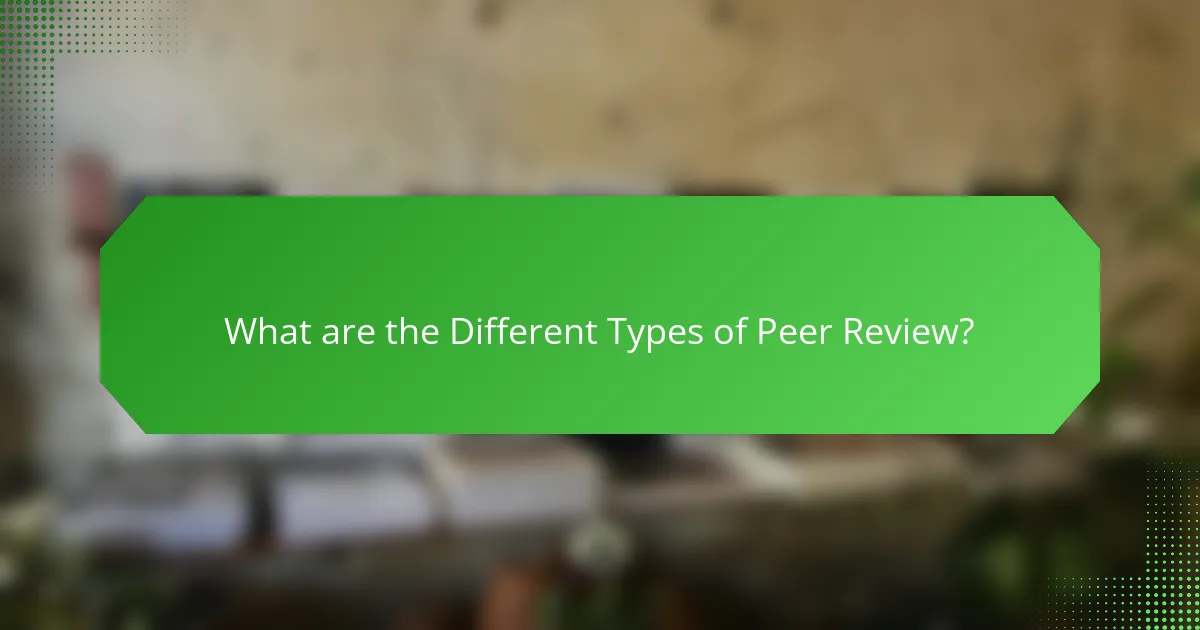
What are the different types of Peer Review?
The different types of peer review are single-blind, double-blind, open, and post-publication review. In single-blind review, the reviewers know the authors’ identities, but authors do not know the reviewers. This can lead to bias but helps reviewers be more candid. In double-blind review, both authors and reviewers remain anonymous to each other. This method aims to reduce bias related to identity and affiliation. Open peer review involves transparency, where both authors and reviewers are known to each other. This can enhance accountability but may deter honest feedback. Post-publication review occurs after a work is published, allowing the community to critique and discuss the research. This can lead to ongoing improvements and corrections.
What are the main types of peer review?
The main types of peer review are single-blind, double-blind, and open peer review. In single-blind peer review, the reviewers know the authors’ identities, but authors do not know who the reviewers are. This format is common in many academic journals. In double-blind peer review, both the authors and reviewers remain anonymous to each other. This method aims to reduce bias and is increasingly favored in various disciplines. Open peer review allows both authors and reviewers to know each other’s identities. This approach promotes transparency and accountability in the review process. Each type has distinct advantages and disadvantages, impacting the quality and integrity of the review.
How does single-blind peer review work?
Single-blind peer review is a process where the reviewers know the identity of the authors, but the authors do not know the identities of the reviewers. In this system, submitted manuscripts are evaluated by experts in the field. Reviewers assess the quality, relevance, and originality of the work. They provide feedback and recommendations for improvement. The anonymity of the reviewers allows for unbiased evaluations. This process can enhance the rigor of the review. However, it may also lead to bias if reviewers feel they can act without accountability. Overall, single-blind peer review is a widely used method in academic publishing.
What are the characteristics of double-blind peer review?
Double-blind peer review is a process where both the reviewers and the authors remain anonymous to each other. This anonymity helps to eliminate bias based on the author’s identity or affiliation. The process typically involves multiple reviewers assessing the manuscript’s quality, validity, and originality. Reviewers provide constructive feedback to improve the work. The anonymity encourages honest critiques without fear of repercussions. Double-blind peer review is commonly used in academic journals to ensure fairness. Studies indicate that this method can enhance the quality of published research. It is considered a best practice in scholarly publishing.
What are the advantages and disadvantages of each type?
The advantages and disadvantages of peer review types vary significantly. The single-blind review offers anonymity for reviewers, which may encourage honest feedback. However, it may lead to biased evaluations since reviewers’ identities are concealed. The double-blind review protects both authors and reviewers, promoting impartiality. Yet, it can complicate the review process due to the need for anonymity. Open peer review enhances transparency and accountability, fostering constructive feedback. Conversely, it may discourage critical evaluations due to fear of backlash. Each type has unique strengths and weaknesses that influence the quality and integrity of the review process.
What are the pros and cons of single-blind peer review?
Single-blind peer review has both advantages and disadvantages. One pro is that it allows reviewers to provide honest feedback without fear of retribution. This can lead to more constructive criticism. Another advantage is that it encourages more thorough evaluations since reviewers are aware of the authors’ identities. However, a significant con is that it may introduce bias. Reviewers might favor well-known authors or institutions. Additionally, the lack of transparency can lead to questions about the review’s integrity. Overall, while single-blind peer review promotes candid feedback, it also risks potential biases.
How does double-blind peer review enhance objectivity?
Double-blind peer review enhances objectivity by concealing the identities of both authors and reviewers. This anonymity reduces bias in the evaluation process. Reviewers cannot be influenced by the author’s reputation or affiliations. Likewise, authors are less likely to be swayed by the reviewers’ identities. Studies show that double-blind reviews can lead to fairer assessments. A 2017 analysis in the journal “Nature” found that double-blind reviews resulted in more equitable outcomes. This method promotes a focus on the quality of the work rather than personal factors. Overall, it fosters a more impartial review environment.
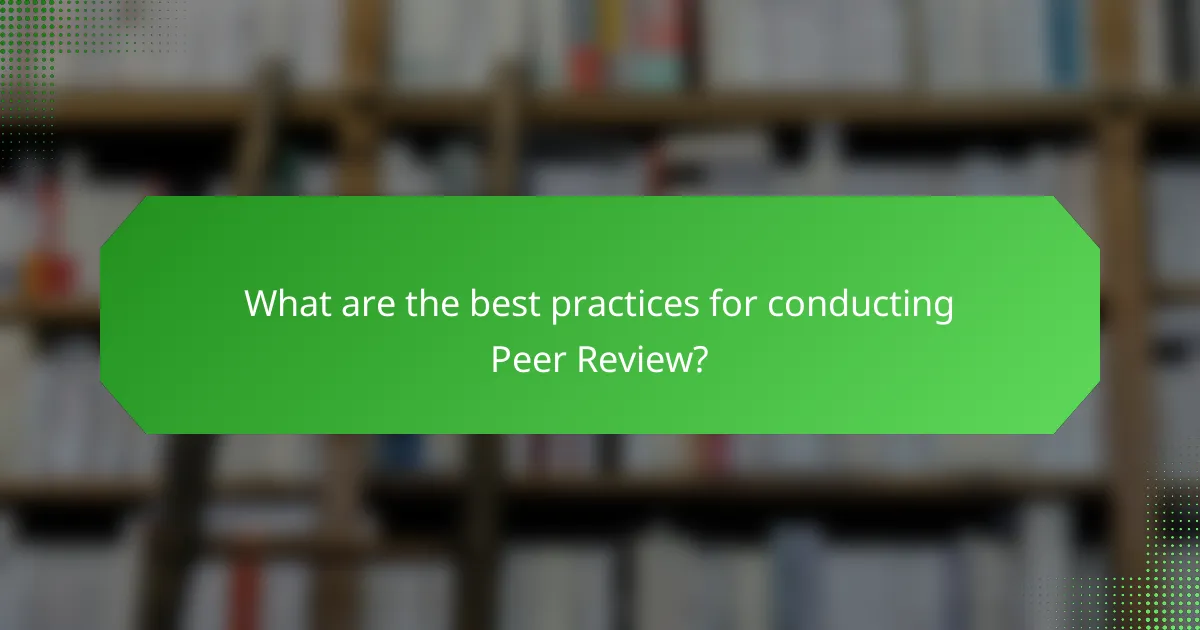
What are the best practices for conducting Peer Review?
Best practices for conducting peer review include maintaining objectivity and confidentiality. Reviewers should assess the manuscript based on its scientific merit and relevance. They must avoid personal biases and conflicts of interest. Providing constructive feedback is essential. Reviewers should clearly articulate strengths and weaknesses. Timeliness in submitting reviews is also crucial. Adhering to journal guidelines ensures consistency and clarity. Lastly, engaging in open communication with editors can enhance the review process. These practices lead to improved quality and integrity in scholarly publishing.
How can reviewers provide constructive feedback?
Reviewers can provide constructive feedback by being specific, actionable, and respectful. Specific feedback focuses on particular aspects of the work, such as methodology or clarity. Actionable suggestions guide authors on how to improve their work. Respectful language fosters a positive environment for discussion. Constructive feedback often includes both strengths and weaknesses of the work. This balanced approach encourages authors to make necessary changes. Studies show that constructive feedback enhances the quality of academic work. According to a 2021 study in the Journal of Academic Ethics, constructive feedback leads to higher satisfaction among authors.
What strategies can be used for effective critique?
Effective critique involves providing constructive feedback. One strategy is to focus on specific aspects of the work. This includes analyzing clarity, coherence, and relevance. Another strategy is to use the “sandwich” method. This method involves starting with positive feedback, followed by areas for improvement, and concluding with additional positive remarks. Additionally, using evidence to support critiques enhances credibility. For instance, referencing specific sections or data strengthens the assessment. Moreover, maintaining a respectful tone fosters open communication. Lastly, encouraging dialogue allows for clarification and deeper understanding. These strategies contribute to a more effective and constructive critique process.
How important is timeliness in the peer review process?
Timeliness is crucial in the peer review process. It affects the overall efficiency of academic publishing. Delays can hinder the dissemination of important research findings. A study by Lee and Bozeman (2005) found that prolonged review times can lead to decreased citation rates. Timely reviews also help maintain the relevance of research in fast-evolving fields. Authors often face pressure to publish quickly to stay competitive. Therefore, timely peer review directly impacts the quality and impact of scholarly communication.
What guidelines should authors follow when submitting for peer review?
Authors should follow specific guidelines when submitting for peer review. They must ensure their manuscript adheres to the journal’s formatting and submission requirements. Authors should provide a clear and concise abstract summarizing their work. They need to include all relevant data and references to support their findings. Transparency regarding conflicts of interest is essential. Authors should ensure that their work has not been submitted elsewhere simultaneously. A thorough review of the manuscript for clarity and coherence is necessary. Finally, authors should respond promptly to any reviewer comments during the revision process. These guidelines help facilitate a smooth peer review and improve the quality of the submission.
How can authors prepare their manuscripts for peer review?
Authors can prepare their manuscripts for peer review by following specific guidelines. First, they should ensure their manuscript adheres to the journal’s formatting and submission requirements. This includes proper referencing and adherence to word limits. Next, authors should conduct a thorough literature review to contextualize their research. They must also clarify their research questions and hypotheses. Additionally, authors should include detailed methodology and results sections. It is essential to provide clear figures and tables for data presentation. Authors should also consider obtaining feedback from colleagues before submission. Finally, they should prepare a cover letter that summarizes the manuscript’s significance and contributions.
What common mistakes should authors avoid during submission?
Authors should avoid submitting manuscripts that do not follow the journal’s guidelines. Each journal has specific formatting and submission requirements. Ignoring these can lead to immediate rejection. Authors must also avoid submitting to multiple journals simultaneously. This practice can create ethical issues and damage reputations. Another common mistake is neglecting to proofread the manuscript. Typos and grammatical errors can distract reviewers from the content. Authors should also ensure that all necessary documents are included. Missing components can delay the review process. Lastly, authors should avoid inadequate responses to reviewer comments. Thoughtful and thorough responses can improve chances of acceptance.
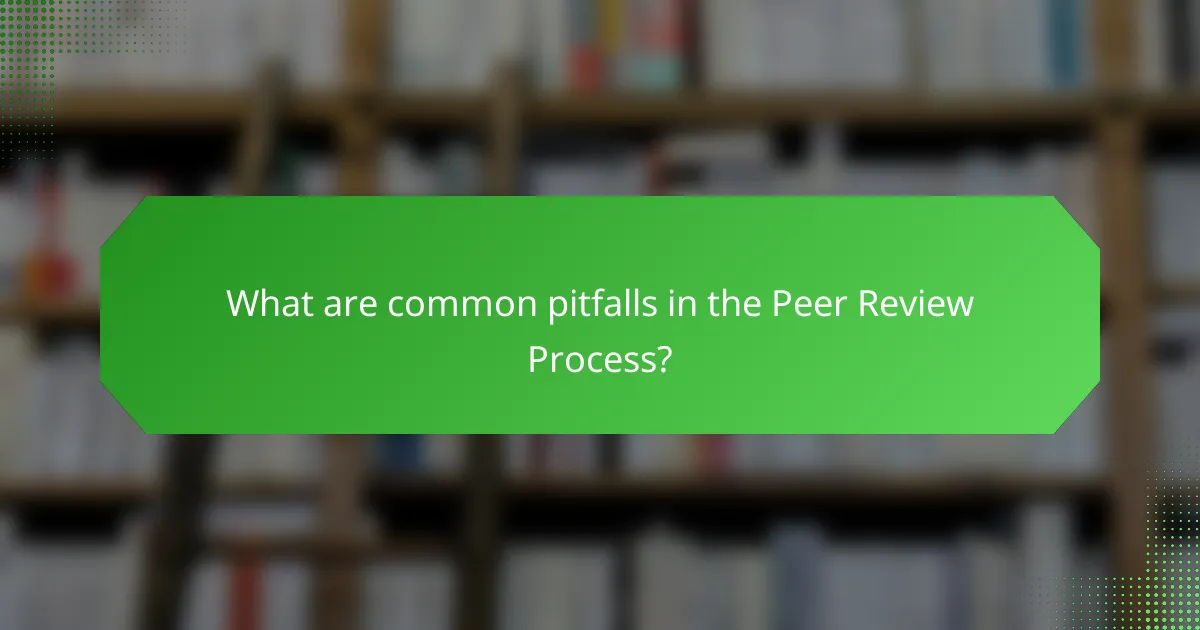
What are common pitfalls in the Peer Review Process?
Common pitfalls in the peer review process include bias, lack of transparency, and inadequate reviewer expertise. Bias can manifest in various forms, such as personal preferences or conflicts of interest. Lack of transparency may arise from anonymous reviews that do not disclose reviewer identities, making accountability difficult. Inadequate reviewer expertise can lead to poor evaluations of the manuscript’s quality and relevance. Research indicates that these issues can compromise the integrity of the peer review system. For instance, a study by Lee et al. (2013) highlights how bias affects publication outcomes in scientific journals.
What are the most frequent challenges faced by reviewers?
Reviewers frequently face challenges such as time constraints, lack of expertise, and biased evaluations. Time constraints often arise due to tight deadlines imposed by journals. This pressure can lead to rushed reviews, impacting quality. Lack of expertise can occur when reviewers are asked to evaluate topics outside their specialty. This may hinder their ability to provide thorough assessments. Biased evaluations can stem from personal relationships or conflicts of interest. Such biases can compromise the objectivity of the review process. Additionally, reviewers may struggle with unclear guidelines from journals, making it difficult to meet expectations. These challenges collectively affect the integrity and effectiveness of the peer review process.
How can bias affect the peer review outcome?
Bias can significantly impact the peer review outcome by influencing the evaluation of a manuscript’s quality. Reviewers may favor studies that align with their own beliefs, leading to unfair assessments. This can result in the rejection of valuable research that contradicts popular opinions. Bias can also manifest in gender, institutional, or geographic preferences, affecting the objectivity of the review. Research has shown that bias in peer review can lead to a lack of diversity in published studies, which skews the scientific literature. Such biases undermine the integrity of the peer review process and can hinder scientific progress.
What happens when reviewers lack expertise?
When reviewers lack expertise, the quality of the peer review process suffers. Inaccurate assessments may occur due to insufficient knowledge. This can lead to the acceptance of flawed research. It may also result in the rejection of valid studies. Reviewers without expertise may miss critical errors in methodology. They might overlook significant contributions to the field. Consequently, the integrity of published research is compromised. Studies indicate that expert reviewers provide more constructive feedback, enhancing overall quality.
How can authors navigate the peer review process effectively?
Authors can navigate the peer review process effectively by understanding the process and preparing thoroughly. Familiarizing themselves with the journal’s guidelines is essential. Authors should ensure their manuscript adheres to formatting and submission requirements. Engaging with peer reviewers’ feedback is crucial for improvement. Authors must respond to comments comprehensively and respectfully. Clear communication with the journal editor can help clarify any uncertainties. Additionally, authors should be patient, as the review process can take time. Research indicates that well-prepared submissions often lead to smoother reviews and higher acceptance rates.
What steps can authors take to address reviewer comments?
Authors can address reviewer comments by carefully reading and understanding each comment. They should categorize the comments into major and minor revisions. Authors must respond to every comment, providing a clear explanation of how they addressed the feedback. If authors disagree with a comment, they should respectfully explain their reasoning. It is beneficial to provide specific examples or references that support their responses. Authors should also revise their manuscript accordingly and highlight changes made. Finally, they should include a cover letter summarizing their responses to the reviewers. This structured approach enhances clarity and demonstrates professionalism in the revision process.
What tips can enhance the peer review experience for all parties?
Clear communication enhances the peer review experience for all parties. Establishing expectations upfront helps reviewers understand their roles. Providing detailed guidelines on the review process ensures consistency. Timely feedback keeps the process moving efficiently. Constructive criticism fosters a positive environment for authors. Acknowledging the contributions of reviewers encourages ongoing participation. Utilizing a structured format for reviews aids clarity and focus. Finally, maintaining confidentiality builds trust among all participants.
The Peer Review Process is a critical evaluation method used to assess the quality and credibility of academic research before publication. This article covers the various types of peer review, including single-blind, double-blind, and open peer review, highlighting their advantages and disadvantages. It also discusses best practices for conducting peer reviews, the importance of timely feedback, and common pitfalls such as bias and lack of expertise that can affect the review process. Additionally, it provides guidelines for authors on how to effectively navigate peer review and respond to reviewer comments, ensuring a smoother publication experience.
